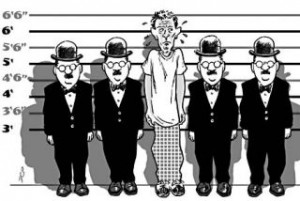My math professor recently showed my class an exam question made by his Chinese colleague. The question, which the professor included in his class’s previous exam, listed 4 pictures of similar-aged Chinese males and asked the students which professor is theirs. The question was intended to stump the students who did not consistently show up to class, but my professor explained that even those who came to class regularly still struggled with the question. He then went on to discuss his own difficulty as a Chinese man with recognizing the faces of his non-Chinese students. So, why is it so difficult to differentiate people of races different from our own?
Known to many as the other-race effect or own-race bias, trouble with facial recognition starts as early as infancy. Psychologists explain that in one study, they tested the ability of 3, 6, and 9 month old Caucasian infants to distinguish Caucasian, African, Middle Eastern, and Chinese faces. Having no former visual image of race, the 3-month-olds recognized faces of all races, whereas the 9-month-olds could only recognize Caucasian faces. Recognition accuracy at later ages is due to the infant’s sociocultural exposure and experience, although it is possible for the other-race effect to be prevented or reversed.
An experiment by Sangrigoli and Schonen concluded that in Caucasian infants, the other-race effect is reversed after 2 minute exposure to photographs of people of other races. However, older infants require greater exposure to other races in order to reverse the effect. When considering the effect of adoption on the other-race effect, scientists have found that people’s own-race bias disappears after around 20 years of exposure to another race. These researchers conducted a study which tested the reversibility of the other-race effect in children. The subjects, Korean adults who were adopted into Caucasian families during their childhood, were able to recognize Caucasian faces better than they were able to recognize Asiatic faces. They yielded the same results as Caucasian subjects, whereas another group of Korean subjects yielded the opposite results. This data lead the researchers to conclude that the other-race effect can be reversed, despite childhood exposure.
So why does the other-race effect exist in the first place? According to this article, people base facial differences on dimensions that differ between races. For example, a feature that differs from person to person of one race may not differ much between people of another race. Similarly, this article explains that by familiarizing ourself with others of our own race, we begin to separate faces based on facial features, which are less effective for separating faces of other races. Additionally, people develop scanning techniques for faces of their own race that they generally do not display when looking at people of other races. Because signs of this technique begin around the same time that the other-race effect develops, they are most likely linked.

This image came from https://www.psychologytoday.com/blog/culture-conscious/201208/the-truth-about-they-all-look-alike-me
In conclusion, the other-race effect is significant for a number of reasons, including how it is a flaw in the criminal justice system. In court cases, eyewitnesses can be less accurate, and in general, minorities receive unequal treatment because of inaccurate facial recognition. The other-race effect is a common phenomenon, and is not attributed to an individual’s ignorance or racism, but rather to the way the brain processes features of the face starting as early as infancy.
http://pss.sagepub.com/content/18/12/1084.short
http://cdp.sagepub.com/content/22/3/173.full.pdf+html
http://pss.sagepub.com/content/16/6/440.full.pdf+html
http://pec.sagepub.com/content/25/6/669.full.pdf+html
http://psycnet.apa.org/journals/law/7/1/98/

